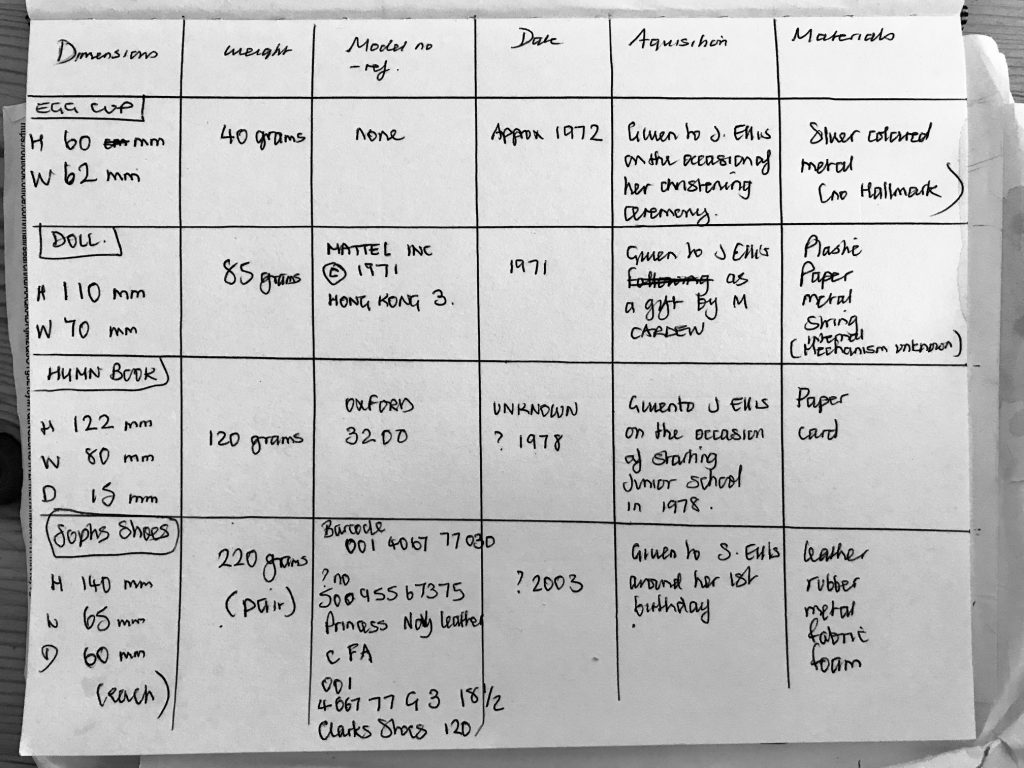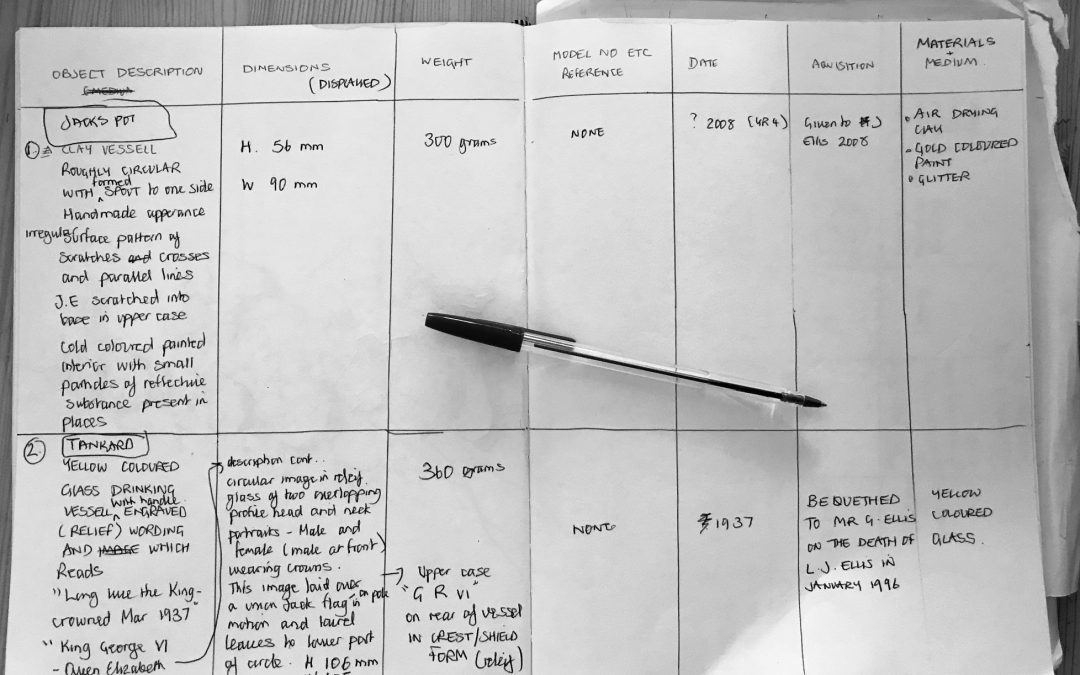
Following on from previous post … I spent some time briefly researching how objects were archived by museums and galleries. What information do they include? When applying this process to my objects the descriptions were the most difficult part of the process. I found it hard to detach myself from my objects in a non emotional way and not to include what I knew to be fact, for example using terms like ‘silver coloured metal’. The easier aspects were measuring, weighing, listing materials and so on. I didn’t expect to get to know my objects in a way that this process uncovered, I found it insightful but also humorous as there were things which I hadn’t noticed such as my scribbles in the Hymn book and the ridiculousness of the talking doll.
The following are the texts from my description in rough;
- Handmade clay Vessel
Clay vessel, roughly circular in shape with a crudely formed spout to one side. Handmade in appearance. There is an irregular surface pattern consisting of crosses and short parallel lines in an alternate formation circling the outside of the vessel. There is an uppercase JE scratched into the surface at the base of the object. The interior and lip of the vessel is painted with gold coloured pigment which contains small fragments of reflective particles in places.
- Tankard – Commemorative King George Tankard
Yellow coloured transparent drinking vessel with handle to the right-hand side. The front of the vessel has a relief image and text which reads ‘Long Live The King Crowned 1937’. This text circles an image of two overlapping profile portraits (head and shoulders), one male at front and a female to the rear. Both portraits are wearing royal crowns. The inner circle contains smaller text which reads ‘King George VI Queen Elizabeth Coronation’ in uppercase lettering. This circular image is laid over an image of the Union Jack flag on pole which appears to be in motion. A small semi-circular line of leaves is set beneath the image. On the opposite side of the vessel is a shield form in relief containing the initials GR VI.
- Silver egg cup
Silver coloured (slightly discoloured) metal egg cup. The circumference of the base is wider than the cup itself and is patterned with a scalloped edge as is the upper lip of the object. There are circular ridges to the base section which are in relief. There is a cut out crescent shape set into the base which is a place to hold a spoon.
- Doll – Mattel Happy Talk-up Pull string Toy.
Plastic molded doll with large head which is roughly half of the overall height of the doll itself. The oversized head is hollow and holds the animated mechanism and sound for the doll. In appearance it has molded yellow coloured hair with an inset flat face area. The face area is covered with a sticker which has printed cartoon-like features with circular brown eyes and a widely drawn smiling mouth. The features are female in appearance and consists of blue eye makeup, long dark eye lashes and pink coloured circular cheek depictions. The paper surface of the face sticker is scratched in places; however, the features are clearly visible. To the rear of the head is a bow shaped cut -out speaker area for the sound to be heard which also incorporates a plastic looped handle which is 110mms in length. The body is a separate solid plastic form connected by an internal string mechanism within the head area and is much smaller to the head with less detail. The upper half of the body area is peach coloured, unclothed and has arms outstretched to the sides. The hands are formed without fingers and a thumb is present. The lower half of the body is bright orange in colour and has forward facing solid molded feet with flat bases. The doll can stand if placed carefully. The animated and sound function of the doll requires one to pull the head in an outward action away from the body of the doll and let go when tension is detected. On letting go of the body of the doll a childlike voice will repeat various short phrases. For example, ‘Carry me I’m portable’, ‘I’m pretty tricky uhuh’, ‘Atchoo uhoh’ and ‘I can fit in your pocket’. These phrases are approximately eight in number and are played at random with what appears to be an American spoken accent. On activating the mechanism There can also be heard a crackling static sound as the recording plays. As the spoken phrase plays the string shortens and returns the head to the body.
- Hymn Book – Songs of Praise
Pocket sized book, the cover, blue in colour with an inset image in dark blue which depicts two profiled feeding deer in a forest clearing. The image is that which is similar to a linocut image and set within a roughly circular shape. Above the image in upper case Times new roman lettering are the words ‘SONGS OF PRAISE’ This is repeated on the spine of the book reading from top to bottom and beneath this is the word OXFORD in smaller uppercase lettering. On the back of the cover set to the lower right-hand side are the numbers 3200. The cover shows signs of wear and is slightly misshapen but otherwise is not damaged. The front inside cover to the left is imperfect and shows signs of possible water damage. There are signs of possible missing pages as the contents page begins on five and there appears to be close tearing close to the spine. Evidence of missing pages can also be found between pages six and nine. There is a large spot of blue ink which appears to be scribbled and deliberate roughly in the centre and the name Julie Cardew also in blue ink above this mark. This writing seems to have been executed by a child. Below the ink spot there is what appears to be an adult’s handwritten inscription which reads ‘Personal property of Julie Cardew 31, Bard Pk Rd. Peverell. Followed by some additional lettering which cannot be read due to deterioration of the surface. On the first page to the right (Titled Contents) the contents are listed in Parts and a childlike inscription reading HYM BOOK in uppercase lettering can be read. To the back of this page written in pencil by what appears to be a child’s writing reads ‘I love horses’ and there is evidence of a horse drawing which has been rubbed away perhaps deliberately using a pencil eraser. The main body of the book contains several hundred traditional Hymns relating to the Christian Bible and are numbered accordingly. The pages show signs of use but are not damaged and can be read easily. On page sixteen there is a pink mark to the upper left-hand side which appears to be a number two. All pages seem to be intact other than those mentioned previously. On the inner side of the back cover there are some markings which are upside down in orientation and read in list from as follows; A =E, T = 1, = = M, + = A, and 1 =E. There is a line of writing which has been scribbled out and cannot be read.
- Childs Shoes – Princess Navy leather
Pair of child’s shoes, Navy blue in colour with a leather finish and silver metal coloured buckle T-bar fastening to front. The lining of the shoe is also of a leather finish dark pink in colour. The silver buckle had a raised barefoot footprint on the main body of the fastening. The stitching of the shoe is visible and appears to be navy blue cotton. The shoe is a rounded toe design with a heart shaped motif double stitched into the front of the shoe, this contains a section of lighter blue leather. The sole of the shoe is made of a rubbery material and is approximately 15 – 20 mm thick and moulded onto the body of the shoe. The base of the shoe has a lined pattern which in the centre features the footprint design as on the buckle of the shoe. The brand name Clarks can be seen embossed into the shoe and reads lengthways. Set to one side is the number three within a small circle. The condition of the shoes is very good and shown little wear aside from some visible scuffing to the front toe section which can be seen on both shoes similarly.

Recent Comments